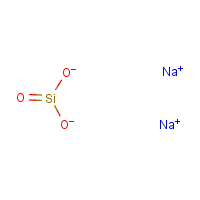Sodium metasilicate
Agent Name
Sodium metasilicate
CAS Number
6834-92-0
Formula
O3-Si.2Na
Major Category
Metals

Synonyms
Silicic acid, disodium salt; B-W; Crystamet; Disodium metasilicate; Disodium monosilicate; Metso 20; Metso beads 2048; Metso beads, drymet; Metso Pentabead 20; Orthosil; Silicic acid (H2SiO3), disodium salt; Simet A; Sodium metasilicate, anhydrous; Sodium silicate; Sodium silicate (Na2SiO3); Water glass; [ChemIDplus] Silicic acid, sodium salt; Disodium trioxosilicate; [ICSC] UN3253
Category
Metals, Inorganic Compounds
Description
White solid; [Hawley] Colorless to white hygroscopic solid; [ICSC] White odorless granules; [Alfa Aesar MSDS]
Sources/Uses
Used as a starting material for zeolites and silica catalysts, as an adhesive and binder, corrosion inhibitor, penetrating sealant, in cements, drilling fluids, for fireproofing wood, paper, and fabric, as a detergent booster, in waste water treatment, and as shell coating to preserve eggs; [Merck Index] Used in boiler compounds, cleaners (laundry, dairy, floor, and metal), bleaches, aluminum paint strippers, pesticides (insecticides, fungicides, and antimicrobials), for deinking paper, and washing carbonated drinking bottles; Generally recognized as safe (GRAS) when directly added to human food; ". . . Exempted from the requirement of a tolerance when used as a surfactant, emulsifier, wetting agent, suspending agent, dispersing agent, or buffer . . ." [HSDB] Modifies water hardness in soaps and detergents; Also used as anti-corrosive agent in boiler water; Produced in anhydrous, pentahydrate, and nonahydrate forms; [IPCS-PIMs] Alkali metal silicates are used as starting materials for products like silicas and zeolites, in detergents and cleaners, and pulp and paper production; Also used to a lesser extent in soil stabilization and sealing, adhesives and binders (construction materials, paperboard and cardboard, ceramic binders, refractories, welding rods, and foundry molds and cores), surface coatings (titanium dioxide production, paints for masonry and glass, and spray coatings for tunnel construction and mining), water/wastewater treatment, enhanced oil recovery, and textile processing (bleach and dye stabilizing); [OECD SIDS: Soluble Silicates - 2004]
Comments
A corrosive substance that can cause injury to the skin, eyes, and respiratory tract; [ICSC] A strong skin, eye, and mucous membrane irritant; [CAMEO] Causes burns; A respiratory tract irritant; [IUCLID] In high-dose, 4-week feeding studies of dogs and rats, polydipsia and polyuria were observed; Dogs but not rats had renal lesions; Oral LD50 (rat) = 1280 mg/kg (10% solution); [HSDB] pH of 1% solution = 13; [IPCS-PIMs] No reports on reproductive effects; [REPROTOX] Corrosive to moistened rabbit skin; Not sensitizing in a local lymph node assay study of mice; Similar uses and adverse effects are expected from the hydrous and anhydrous forms (Sodium metasilicate pentahydrate, Sodium metasilicate nonahydrate, Sodium metasilicate, Sodium silicate, and Potassium silicate). One case of occupational contact urticaria reported from sodium silicate; [OECD SIDS: Soluble Silicates - 2004] A severe skin irritant; Human ingestion of 1 mL/kg causes changes in tubules (including acute renal failure and necrosis), hematuria, and nausea or vomiting; [RTECS] Causes burns; Inhalation may cause corrosive injuries to upper respiratory tract and lungs; [Alfa Aesar MSDS]
Biomedical References
Adverse Effects
Toxic Pneumonitis
Yes
Nephrotoxin
Yes
Dermatotoxin
Skin burns
Diseases, Processes, and Activities Linked to This Agent
Processes
Industrial Processes with risk of exposure: